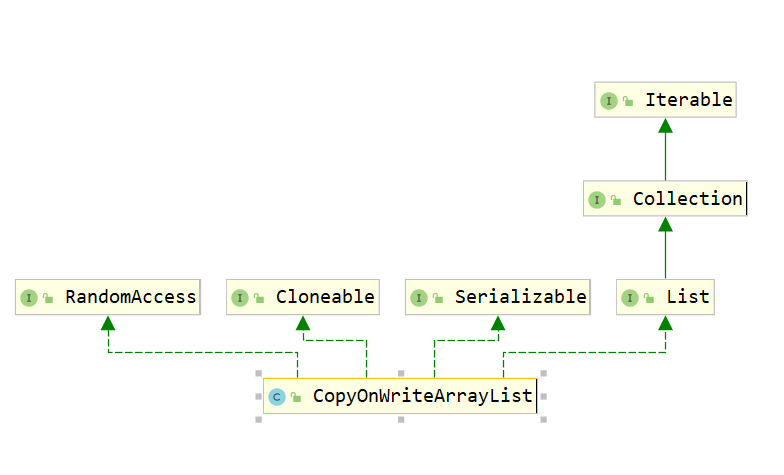简介
CopyOnWriteArrayList是ArrayList的线程安全版本,内部也是通过数组实现,每次对数组的修改都完全拷贝一份新的数组来修改,修改完了再替换掉老数组,这样保证了只阻塞写操作,不阻塞读操作,实现读写分离。
继承体系

CopyOnWriteArrayList实现了List, RandomAccess, Cloneable, java.io.Serializable等接口。
CopyOnWriteArrayList实现了List,提供了基础的添加、删除、遍历等操作。
CopyOnWriteArrayList实现了RandomAccess,提供了随机访问的能力。
CopyOnWriteArrayList实现了Cloneable,可以被克隆。
CopyOnWriteArrayList实现了Serializable,可以被序列化。源码分析
主要属性
/**
* The lock protecting all mutators
* 用于修改时加锁
*/
final transient ReentrantLock lock = new ReentrantLock();
/**
* The array, accessed only via getArray/setArray.
* 真正存储元素的地方,只能通过getArray()/setArray()访问
*/
private transient volatile Object[] array;(1)lock
用于修改时加锁,使用transient修饰表示不自动序列化。
(2)array
真正存储元素的地方,使用transient修饰表示不自动序列化,使用volatile修饰表示一个线程对这个字段的修改另外一个线程立即可见。
问题:为啥没有size字段?
CopyOnWriteArrayList()构造方法
创建空数组:
/**
* Creates an empty list.
*/
public CopyOnWriteArrayList() {
setArray(new Object[0]);
}
/**
* Sets the array.
*/
final void setArray(Object[] a) {
array = a;
}CopyOnWriteArrayList 构造方法
如果c是CopyOnWriteArrayList类型,直接把它的数组赋值给当前list的数组,注意这里是浅拷贝,两个集合共用同一个数组。
如果c不是CopyOnWriteArrayList类型,则进行拷贝把c的元素全部拷贝到当前list的数组中。
/**
* Creates a list containing the elements of the specified
* collection, in the order they are returned by the collection's
* iterator.
*
* @param c the collection of initially held elements
* @throws NullPointerException if the specified collection is null
*/
public CopyOnWriteArrayList(Collection<? extends E> c) {
Object[] elements;
if (c.getClass() == CopyOnWriteArrayList.class)
//如果c也是CopyOnWriteArrayList类型,直接把它的数组拿过来使用
elements = ((CopyOnWriteArrayList<?>)c).getArray();
else {
// 否则调用其toArray()方法将集合元素转化为数组
elements = c.toArray();
// c.toArray might (incorrectly) not return Object[] (see 6260652)
// 这里c.toArray()返回的不一定是Object[]类型,详细原因见ArrayList里面的分析
if (elements.getClass() != Object[].class)
elements = Arrays.copyOf(elements, elements.length, Object[].class);
}
setArray(elements);
}CopyOnWriteArrayList(E[] toCopyIn)构造方法
把toCopyIn的元素拷贝给当前list的数组。
/**
* Creates a list holding a copy of the given array.
*
* @param toCopyIn the array (a copy of this array is used as the
* internal array)
* @throws NullPointerException if the specified array is null
*/
public CopyOnWriteArrayList(E[] toCopyIn) {
setArray(Arrays.copyOf(toCopyIn, toCopyIn.length, Object[].class));
}add(E e)方法
添加一个元素到末尾。
/**
* Appends the specified element to the end of this list.
*
* @param e element to be appended to this list
* @return {@code true} (as specified by {@link Collection#add})
*/
public boolean add(E e) {
final ReentrantLock lock = this.lock;
// 加锁
lock.lock();
try {
// 获取旧数组
Object[] elements = getArray();
int len = elements.length;
// 将旧数组元素拷贝到新数组中
// 新数组大小是旧数组大小加1
Object[] newElements = Arrays.copyOf(elements, len + 1);
// 将元素放在最后一位
newElements[len] = e;
setArray(newElements);
return true;
} finally {
// 释放锁
lock.unlock();
}
}(1)加锁;
(2)获取元素数组;
(3)新建一个数组,大小为原数组长度加1,并把原数组元素拷贝到新数组;
(4)把新添加的元素放到新数组的末尾;
(5)把新数组赋值给当前对象的array属性,覆盖原数组;
(6)解锁;
add(int index, E element)方法
添加一个元素在指定索引处。
/**
* Inserts the specified element at the specified position in this
* list. Shifts the element currently at that position (if any) and
* any subsequent elements to the right (adds one to their indices).
*
* @throws IndexOutOfBoundsException {@inheritDoc}
*/
public void add(int index, E element) {
final ReentrantLock lock = this.lock;
// 加锁
lock.lock();
try {
// 获取旧数组
Object[] elements = getArray();
int len = elements.length;
// 检查是否越界, 可以等于len
if (index > len || index < 0)
throw new IndexOutOfBoundsException("Index: "+index+
", Size: "+len);
Object[] newElements;
int numMoved = len - index;
if (numMoved == 0)
// 如果插入的位置是最后一位,那么拷贝一个n+1的数组, 其前n个元素与旧数组一致
newElements = Arrays.copyOf(elements, len + 1);
else {
// 如果插入的位置不是最后一位,那么新建一个n+1的数组
newElements = new Object[len + 1];
// 拷贝旧数组前index的元素到新数组中
System.arraycopy(elements, 0, newElements, 0, index);
// 将index及其之后的元素往后挪一位拷贝到新数组中
// 这样正好index位置是空出来的
System.arraycopy(elements, index, newElements, index + 1,
numMoved);
}
// 将元素放置在index处
newElements[index] = element;
setArray(newElements);
} finally {
// 释放锁
lock.unlock();
}
}(1)加锁;
(2)检查索引是否合法,如果不合法抛出IndexOutOfBoundsException异常,注意这里index等于len也是合法的;
(3)如果索引等于数组长度(也就是数组最后一位再加1),那就拷贝一个len+1的数组;
(4)如果索引不等于数组长度,那就新建一个len+1的数组,并按索引位置分成两部分,索引之前(不包含)的部分拷贝到新数组索引之前(不包含)的部分,索引之后(包含)的位置拷贝到新数组索引之后(不包含)的位置,索引所在位置留空;
(5)把索引位置赋值为待添加的元素;
(6)把新数组赋值给当前对象的array属性,覆盖原数组;
(7)解锁;
addIfAbsent(E e)方法
添加一个元素如果这个元素不存在于集合中。
/**
* Appends the element, if not present.
*
* @param e element to be added to this list, if absent
* @return {@code true} if the element was added
*/
public boolean addIfAbsent(E e) {
// 获取元素数组, 取名为快照
Object[] snapshot = getArray();
// 检查如果元素不存在,直接返回false
// 如果存在再调用addIfAbsent()方法添加元素
return indexOf(e, snapshot, 0, snapshot.length) >= 0 ? false :
addIfAbsent(e, snapshot);
}
/**
* A version of addIfAbsent using the strong hint that given
* recent snapshot does not contain e.
*/
private boolean addIfAbsent(E e, Object[] snapshot) {
final ReentrantLock lock = this.lock;
// 加锁
lock.lock();
try {
// 重新获取旧数组
Object[] current = getArray();
int len = current.length;
// 如果快照与刚获取的数组不一致
// 说明有修改
if (snapshot != current) {
// Optimize for lost race to another addXXX operation
// 重新检查元素是否在刚获取的数组里
int common = Math.min(snapshot.length, len);
for (int i = 0; i < common; i++)
// 到这个方法里面了, 说明元素不在快照里面
if (current[i] != snapshot[i] && eq(e, current[i]))
return false;
if (indexOf(e, current, common, len) >= 0)
return false;
}
// 拷贝一份n+1的数组
Object[] newElements = Arrays.copyOf(current, len + 1);
// 将元素放在最后一位
newElements[len] = e;
setArray(newElements);
return true;
} finally {
// 释放锁
lock.unlock();
}
}(1)检查这个元素是否存在于数组快照中;
(2)如果存在直接返回false,如果不存在调用addIfAbsent(E e, Object[] snapshot)处理;
(3)加锁;
(4)如果当前数组不等于传入的快照,说明有修改,检查待添加的元素是否存在于当前数组中,如果存在直接返回false;
(5)拷贝一个新数组,长度等于原数组长度加1,并把原数组元素拷贝到新数组中;
(6)把新元素添加到数组最后一位;
(7)把新数组赋值给当前对象的array属性,覆盖原数组;
(8)解锁;
get(int index)
获取指定索引的元素,支持随机访问,时间复杂度为O(1)。
/**
* {@inheritDoc}
*
* @throws IndexOutOfBoundsException {@inheritDoc}
*/
public E get(int index) {
// 获取元素不需要加锁
// 直接返回index位置的元素
// 这里是没有做越界检查的, 因为数组本身会做越界检查
return get(getArray(), index);
}
@SuppressWarnings("unchecked")
private E get(Object[] a, int index) {
return (E) a[index];
}
/**
* Gets the array. Non-private so as to also be accessible
* from CopyOnWriteArraySet class.
*/
final Object[] getArray() {
return array;
}(1)获取元素数组;
(2)返回数组指定索引位置的元素;
remove(int index)方法
删除指定索引位置的元素。
/**
* Removes the element at the specified position in this list.
* Shifts any subsequent elements to the left (subtracts one from their
* indices). Returns the element that was removed from the list.
*
* @throws IndexOutOfBoundsException {@inheritDoc}
*/
public E remove(int index) {
final ReentrantLock lock = this.lock;
// 加锁
lock.lock();
try {
// 获取旧数组
Object[] elements = getArray();
int len = elements.length;
E oldValue = get(elements, index);
int numMoved = len - index - 1;
if (numMoved == 0)
// 如果移除的是最后一位
// 那么直接拷贝一份n-1的新数组, 最后一位就自动删除了
setArray(Arrays.copyOf(elements, len - 1));
else {
// 如果移除的不是最后一位
// 那么新建一个n-1的新数组
Object[] newElements = new Object[len - 1];
// 将前index的元素拷贝到新数组中
System.arraycopy(elements, 0, newElements, 0, index);
// 将index后面(不包含)的元素往前挪一位
// 这样正好把index位置覆盖掉了, 相当于删除了
System.arraycopy(elements, index + 1, newElements, index,
numMoved);
setArray(newElements);
}
return oldValue;
} finally {
// 释放锁
lock.unlock();
}
}(1)加锁;
(2)获取指定索引位置元素的旧值;
(3)如果移除的是最后一位元素,则把原数组的前len-1个元素拷贝到新数组中,并把新数组赋值给当前对象的数组属性;
(4)如果移除的不是最后一位元素,则新建一个len-1长度的数组,并把原数组除了指定索引位置的元素全部拷贝到新数组中,并把新数组赋值给当前对象的数组属性;
(5)解锁并返回旧值;
size()方法
返回数组的长度。
/**
* Returns the number of elements in this list.
*
* @return the number of elements in this list
*/
public int size() {
// 获取元素个数不需要加锁
// 直接返回数组的长度
return getArray().length;
}总结
(1)CopyOnWriteArrayList使用ReentrantLock重入锁加锁,保证线程安全;
(2)CopyOnWriteArrayList的写操作都要先拷贝一份新数组,在新数组中做修改,修改完了再用新数组替换老数组,所以空间复杂度是O(n),性能比较低下;
(3)CopyOnWriteArrayList的读操作支持随机访问,时间复杂度为O(1);
(4)CopyOnWriteArrayList采用读写分离的思想,读操作不加锁,写操作加锁,且写操作占用较大内存空间,所以适用于读多写少的场合;
(5)CopyOnWriteArrayList只保证最终一致性,不保证实时一致性;
问题:为什么CopyOnWriteArrayList没有size属性?
因为每次修改都是拷贝一份正好可以存储目标个数元素的数组,所以不需要size属性了,数组的长度就是集合的大小,而不像ArrayList数组的长度实际是要大于集合的大小的。
比如,add(E e)操作,先拷贝一份n+1个元素的数组,再把新元素放到新数组的最后一位,这时新数组的长度为len+1了,也就是集合的size了。


评论加载中